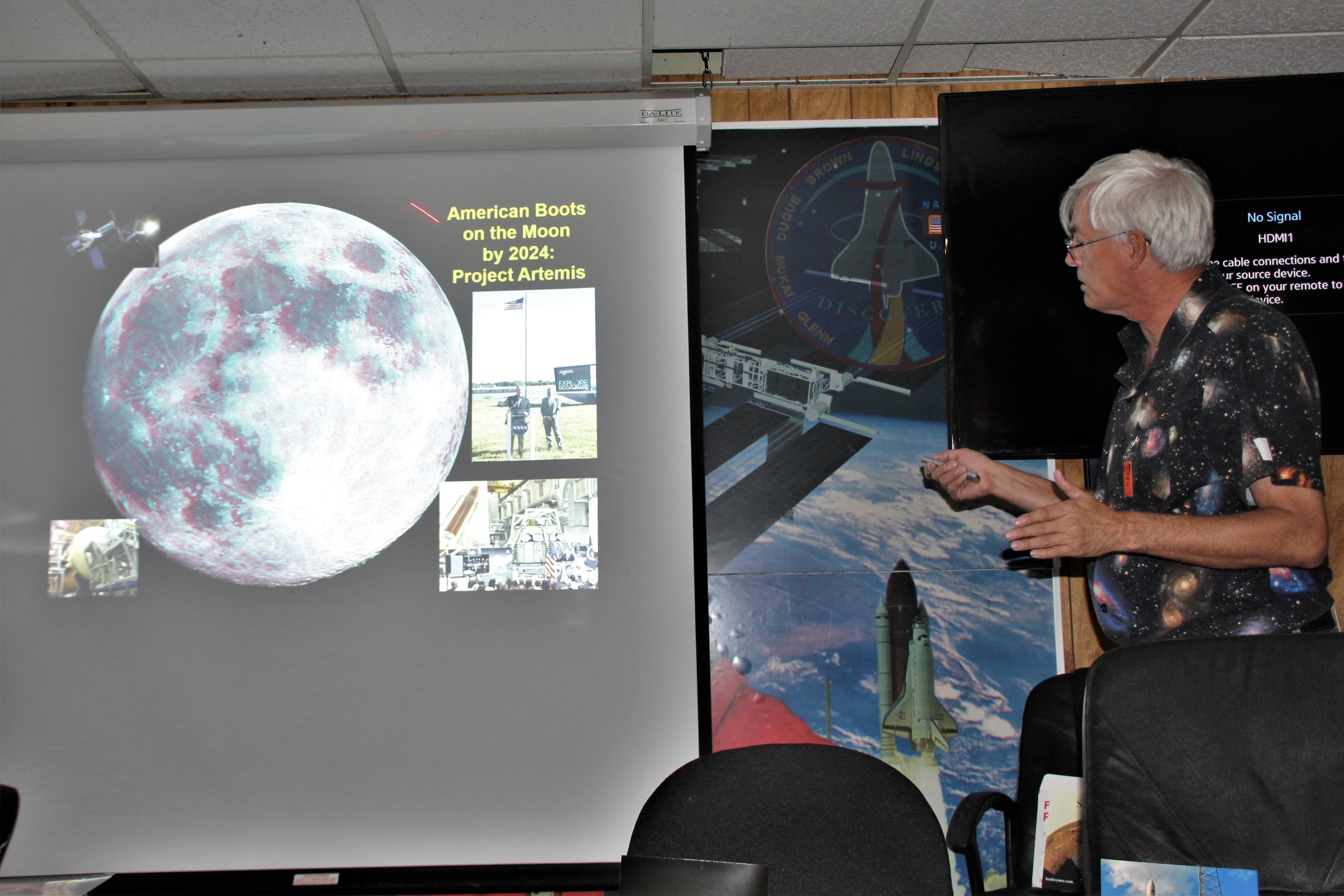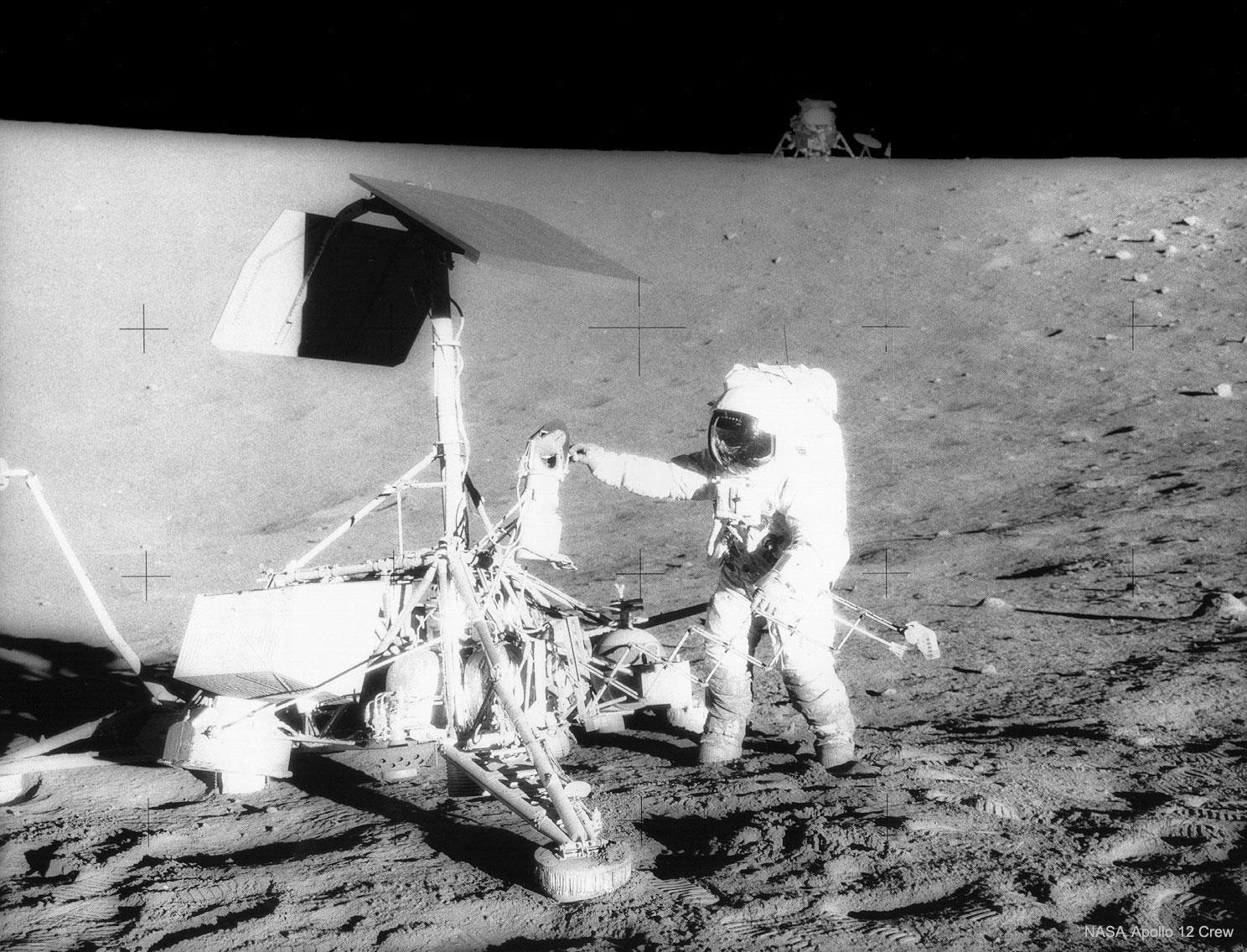
For SpaceUpClose.com & RocketSTEM
Titusville, FL – This month marks the 50th anniversary of the launch of Apollo 12 on Nov. 14, 1969 – which goes down in history as NASA’s second Apollo mission to land humans on the Moon on Nov. 19, 1969 with namely Commander Charles “Pete” Conrad and Lunar Module Pilot (LMP) Alan L. Bean at the ‘Oceans of Storms’ (Oceanus Procellarum) thus becoming the third and fourth humans respectively to set foot on the lunar surface.
The three man Apollo 12 crew of NASA astronauts comprised Commander Charles “Pete” Conrad, Command Module Pilot (CMP) Richard F. Gordon, and Lunar Module Pilot (LMP) Alan L. Bean.
Lightning struck the Saturn V twice at 36 and 52 seconds after liftoff causing much of the command and service module instrumentation and the three fuel cells to go offline with telemetry loss.
A quick call by flight controller John Aaron saved the mission when he recognized the failure mode and said “Flight, EECOM. Try SCE to Aux.”
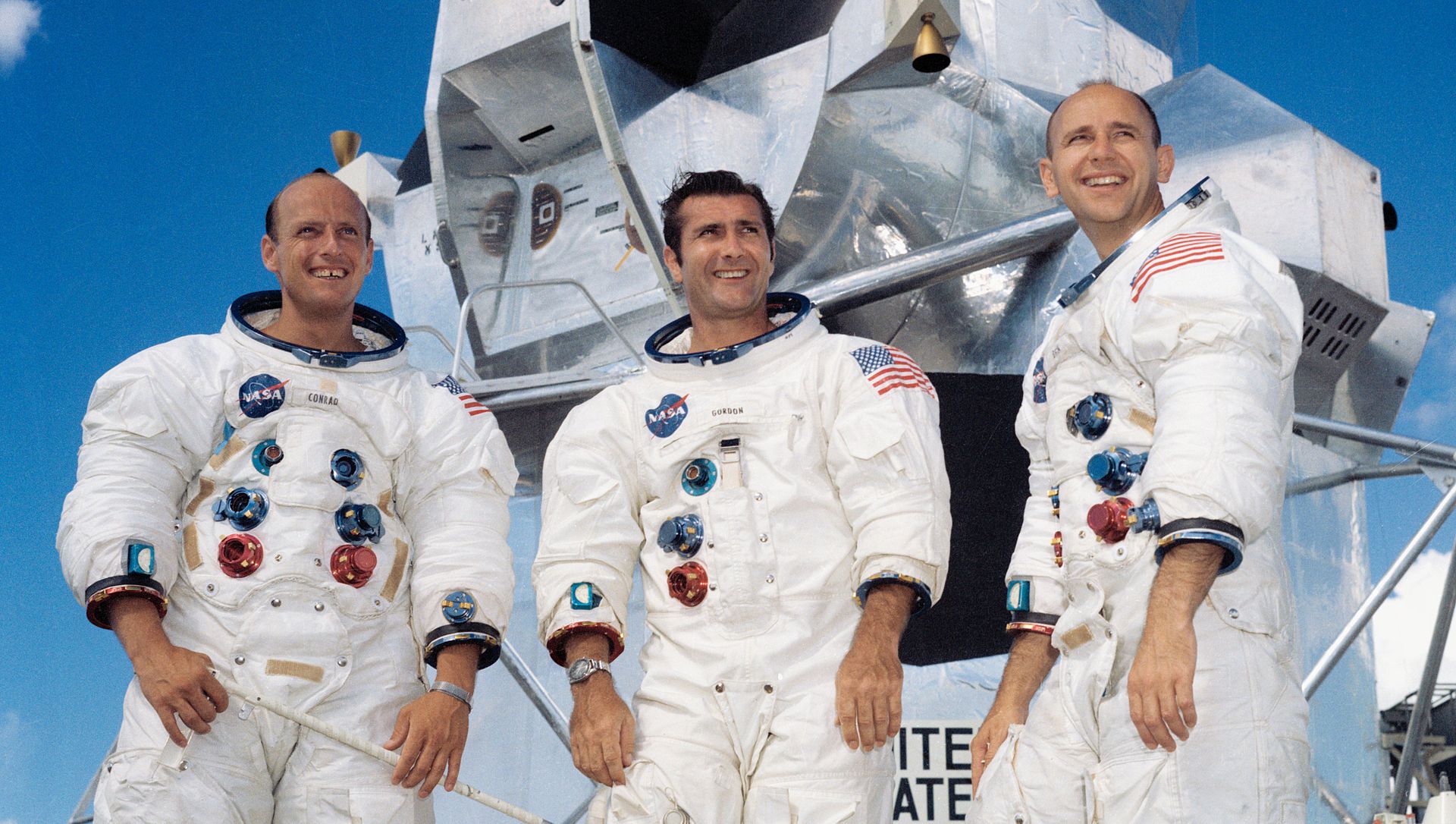
After achieving lunar orbit, Conrad and Bean departed and descended to the surface in the Lunar Module named ‘Intrepid’ while Gordon remained above in lunar orbit in the Command Module ‘Yankee Clipper.’
The Apollo 12 landing came almost exactly 4 months to the day after the 1st landing by Apollo 11 astronauts Neil Armstrong and Buzz Aldrin on July 20, 1969 and thereby accomplished President Kennedy’s objective a second time “of landing a man on the man before this decade is out!”
I’ve included a gallery of selected images from Apollo 12
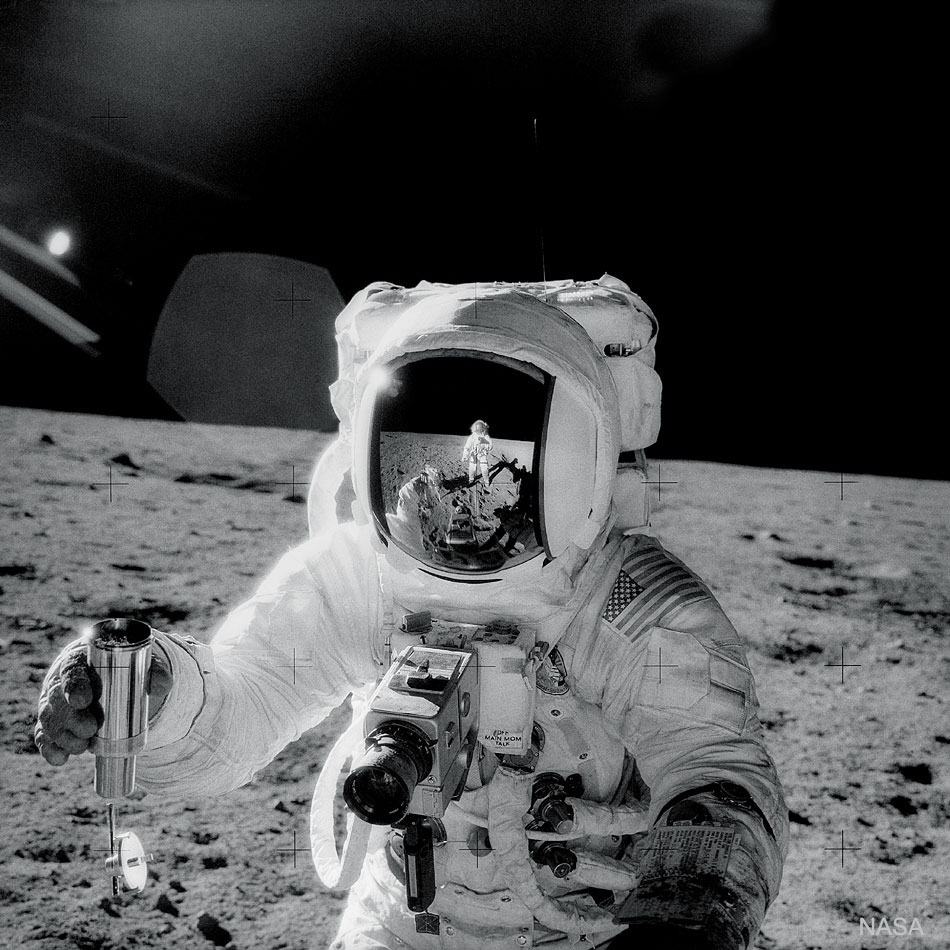
Apollo 12 is also known as the “Pinpoint Mission” because it marks the first and to this date only time humans have landed nearby in close proximity to another spaceship sent to another celestial body by humanity – namely the unmanned Surveyor III which soft landed on the Moon two and a half months earlier on April 20, 1967.
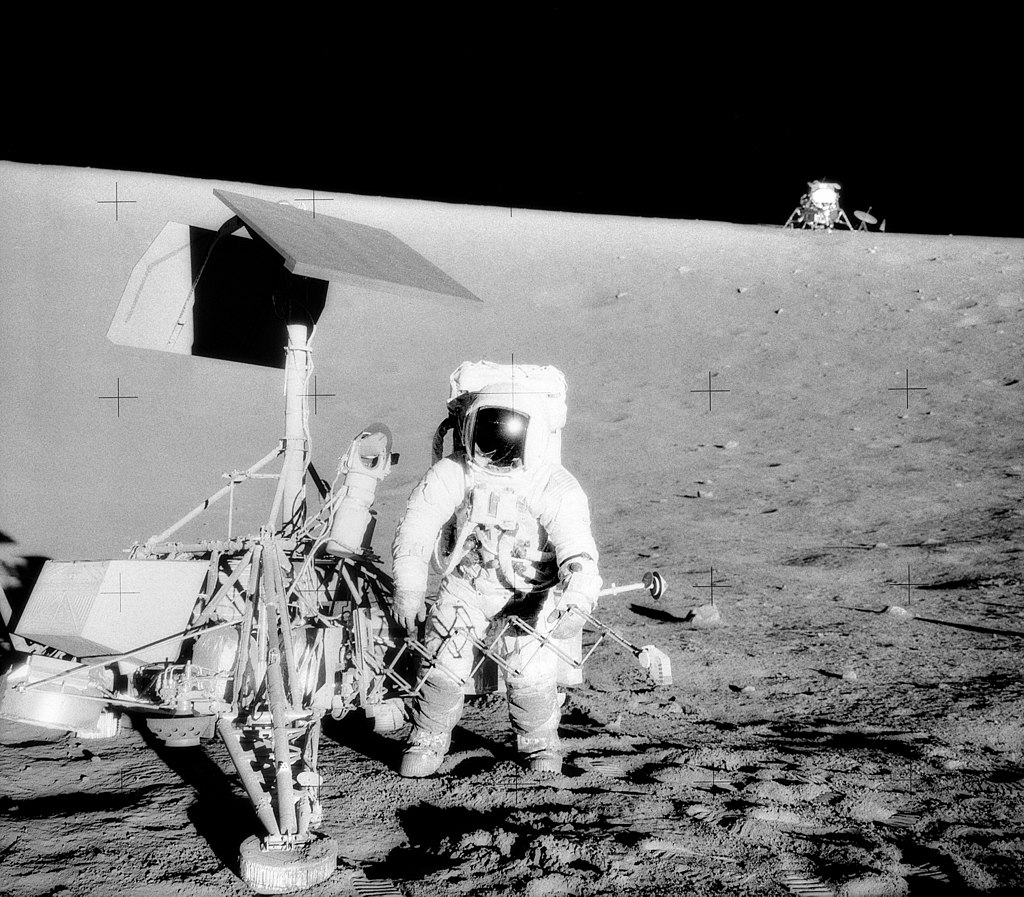
Conrad and Bean achieved a pinpoint landing only about 537 feet away from Surveyor III easily within walking distance.
After blastoff on the mighty NASA Apollo Saturn V on Nov 14, 1969, the Apollo 12 mission lasted for a mission duration of 10 days, four hours, 36 minutes, 25 seconds.
It concluded with a safe parachute assisted splashdown in the Pacific Ocean on Nov. 24, 1969.
Conrad and Bean spent a total of 31 and a half hours on the Moon after landing on Nov.19 on the Ocean of Storms.
They conducted two moon walks, EVA-1 and EVA-2, lasting over about 3 and a half hours each. For a combined total of 7 hours, 45 minutes, 18 seconds.
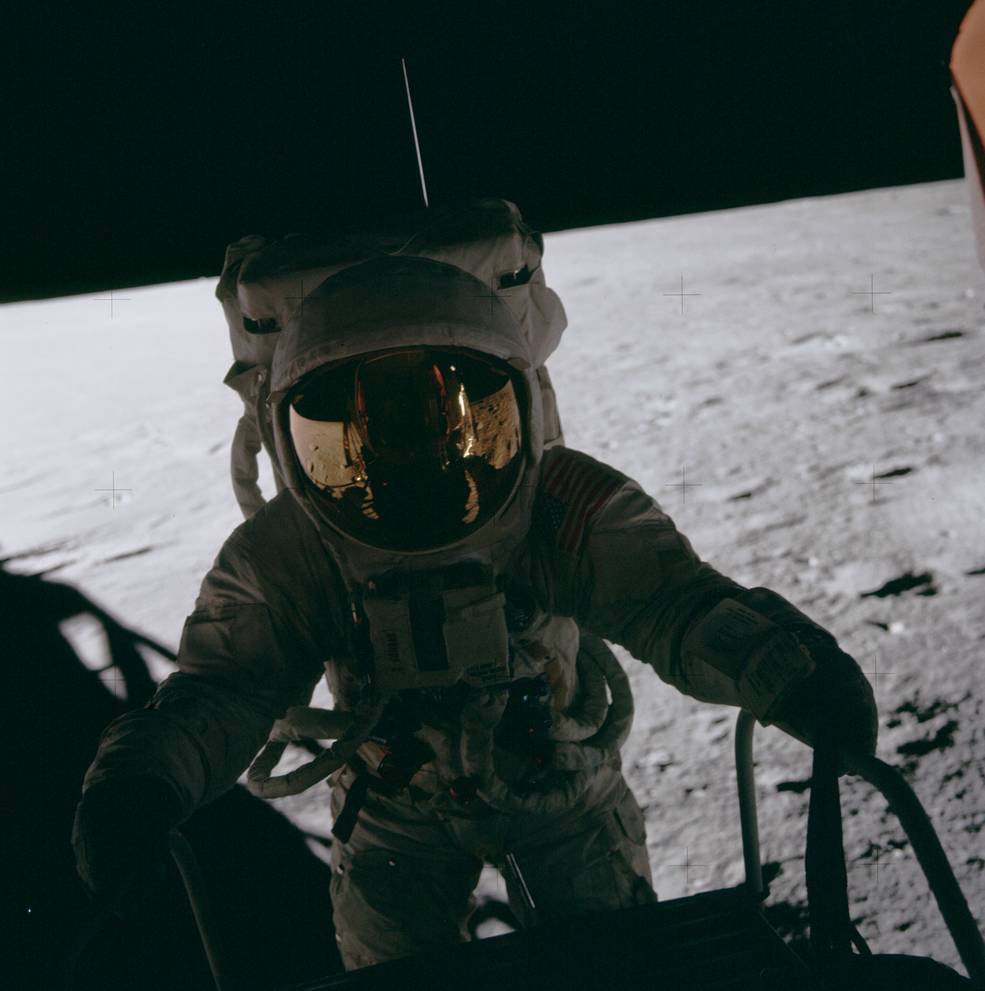
Conrad exited the Lunar Module first followed by Bean.
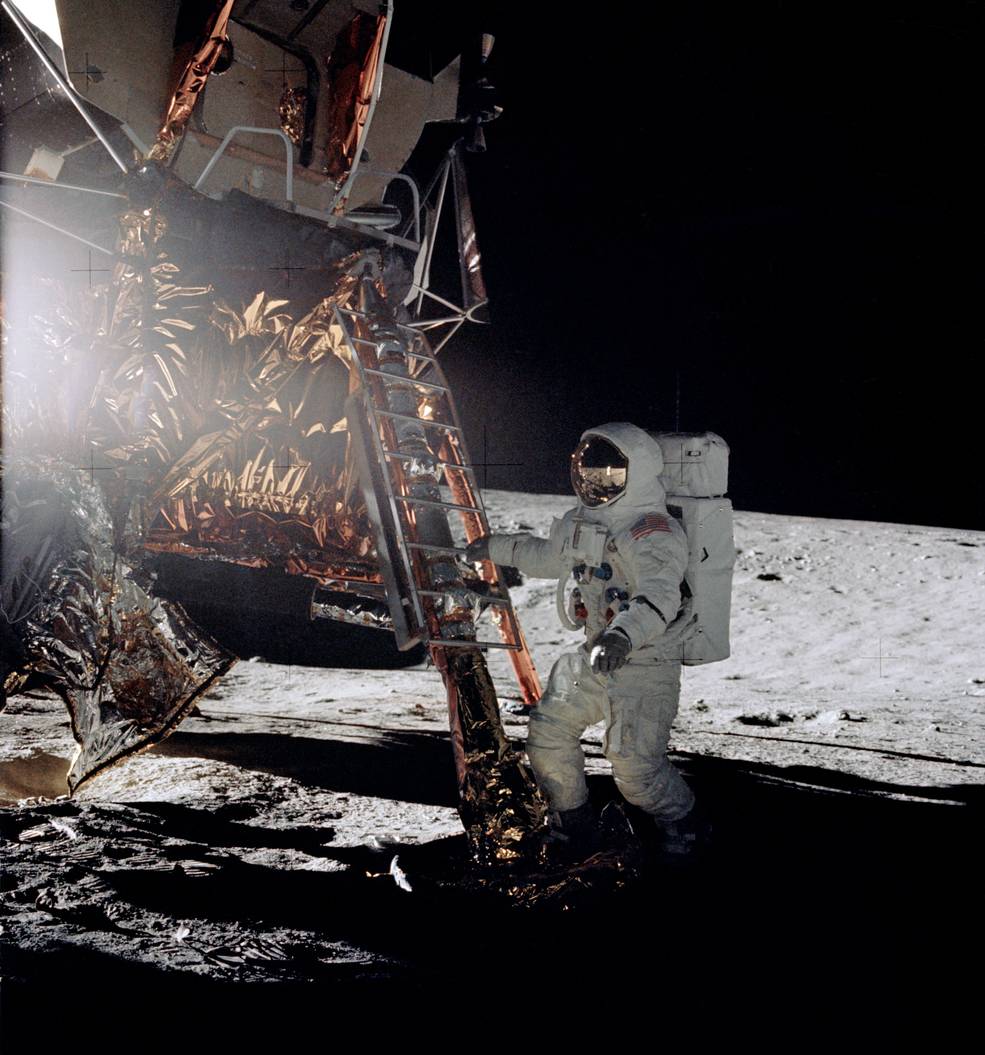
Conrad first words were rather exuberant.
As he jumped from the bottom rung onto the footpad, Conrad exclaimed, “Whoopee! Man, that may have been a small one for Neil, but that’s a long one for me,” in reference to Armstrong’s famous words as he took humanity’s first step on the lunar surface and Conrad’s shorter stature, per NASA description.
They deployed the Apollo Lunar Surface Experiments Package (ALSEP) science package, visited Surveyor III and took a TV camera, sample scoop and other parts for analysis of the long term impact in the space environment.
They collected some 75.7 lbs (34.35 kg) of lunar rock, regolith soil and core samples from below the lunar surface.
Watch this short NASA video summary of Apollo 12:
Video Caption: Apollo 12 launched from Cape Kennedy on Nov. 14, 1969, into a cloudy, rain-swept sky. Launch controllers lost telemetry contact at 36 seconds, and again at 52 seconds, when the Saturn V launch vehicle was struck by lightning. In addition to continuing Apollo’s lunar exploration tasks, Charles Conrad, Alan Bean, and Richard Gordon deployed the Apollo Lunar Surface Experiments Package, a set of investigations left on the Moon’s surface to gather data. Credit: NASA
Here is a detailed description of Apollo 12 timeline from NASA:
Mission Objective
The primary mission objectives of the second crewed lunar landing included an extensive series of lunar exploration tasks by the lunar module, or LM, crew, as well as the deployment of the Apollo Lunar Surface Experiments Package, or ALSEP, which was to be left on the moon’s surface to gather seismic, scientific and engineering data throughout a long period of time.
Other Apollo 12 objectives included a selenological inspection; surveys and samplings in landing areas; development of techniques for precision-landing capabilities; further evaluations of the human capability to work in the lunar environment for a prolonged period of time; deployment and retrieval of other scientific experiments; and photography of candidate exploration sites for future missions.
The astronauts also were to retrieve portions of the Surveyor III spacecraft, which had soft-landed on the moon April 20, 1967, a short distance from the selected landing site of Apollo 12.
The flight plan for Apollo 12 was similar to that of Apollo 11, except Apollo 12 was to fly a higher inclination to the lunar equator and leave the free-return trajectory after the second translunar midcourse correction. This first non-free-return trajectory on an Apollo mission was designed to allow a daylight launch and a translunar injection above the Pacific Ocean. It also allowed a stretch of the translunar coast to gain the desired landing site lighting at the time of LM descent, conserved fuel and permitted the Goldstone, Calif., tracking antenna to monitor the LM descent and landing.
In addition, the Apollo 12 flight plan called for the LM ascent stage to provide a measured seismic stimulus for the ALSEP seismic experiment. Following crew return to the command and service module, or CSM, a controlled burn of the remaining propellants in the empty ascent stage caused the stage to crash into the moon, providing a measurable seismic shock impulse.
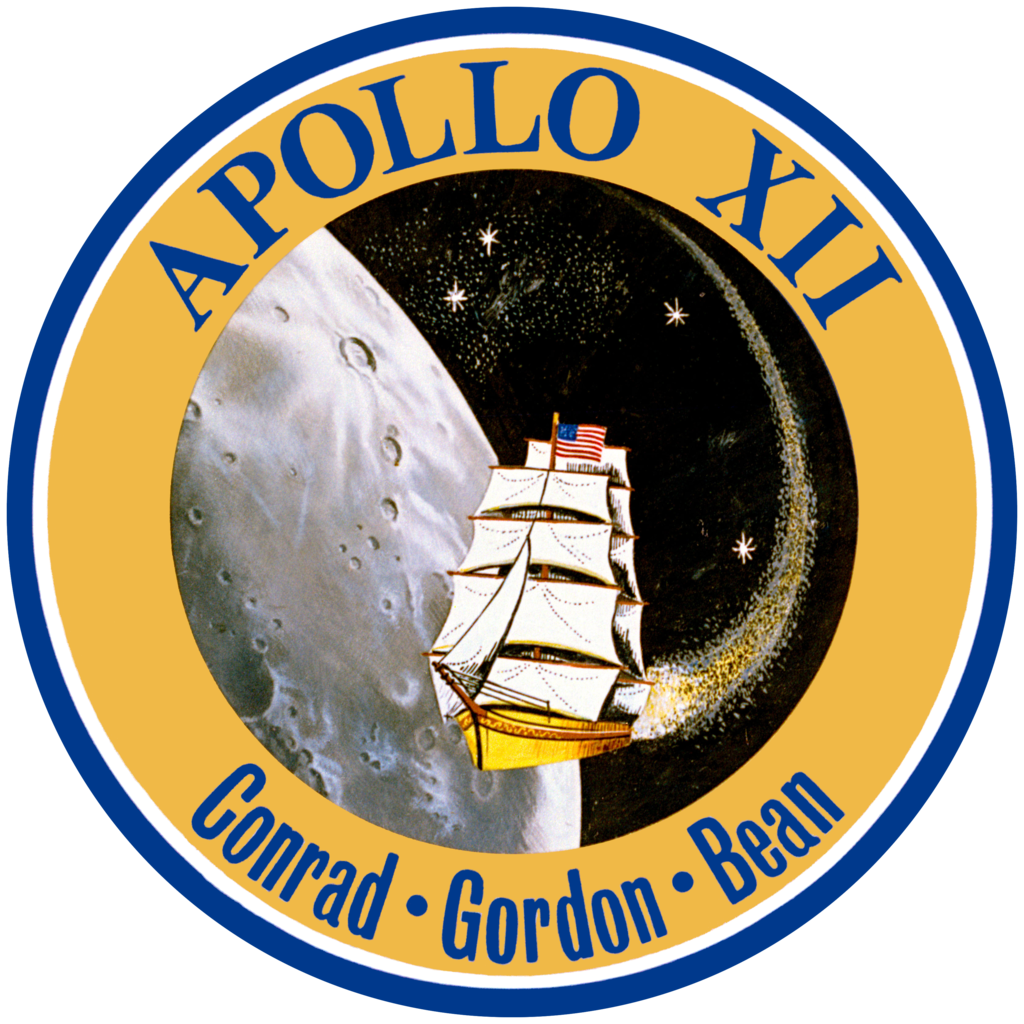
Mission Highlights
Apollo 12 launched from Cape Kennedy on Nov. 14, 1969, into a cloudy, rain-swept sky. Launch controllers lost telemetry contact at 36 seconds, and again at 52 seconds, when the Saturn V launch vehicle was struck by lightning. The booster’s first stage continued firing, launching Apollo 12 into an initial Earth-parking orbit of 115 by 117.9 miles. After one-and-a-half revolutions, the electrical circuits were checked out and no significant problems were noted. Then, the S-IVB stage re-ignited for a second burn of five minutes, 45 seconds, placing Apollo 12 into an initial free-return translunar trajectory.
About 40 minutes later, the CSM Yankee Clipper separated from the S-IVB-SLA, transposed, and then docked with the LM Intrepid. This was televised on Earth. The S-IVB stage was then jettisoned. However, based on incorrect data of trajectory commands, it failed to go into the planned heliocentric orbit. Instead, it was placed into an elliptical Earth-orbit of 101,350 by 535,522 miles, with a period of 42 days. Charles Conrad and Alan Bean entered the LM to check for possible impacts from the lightning strike. They found none and re-entered the CSM for 10 hours of sleep.
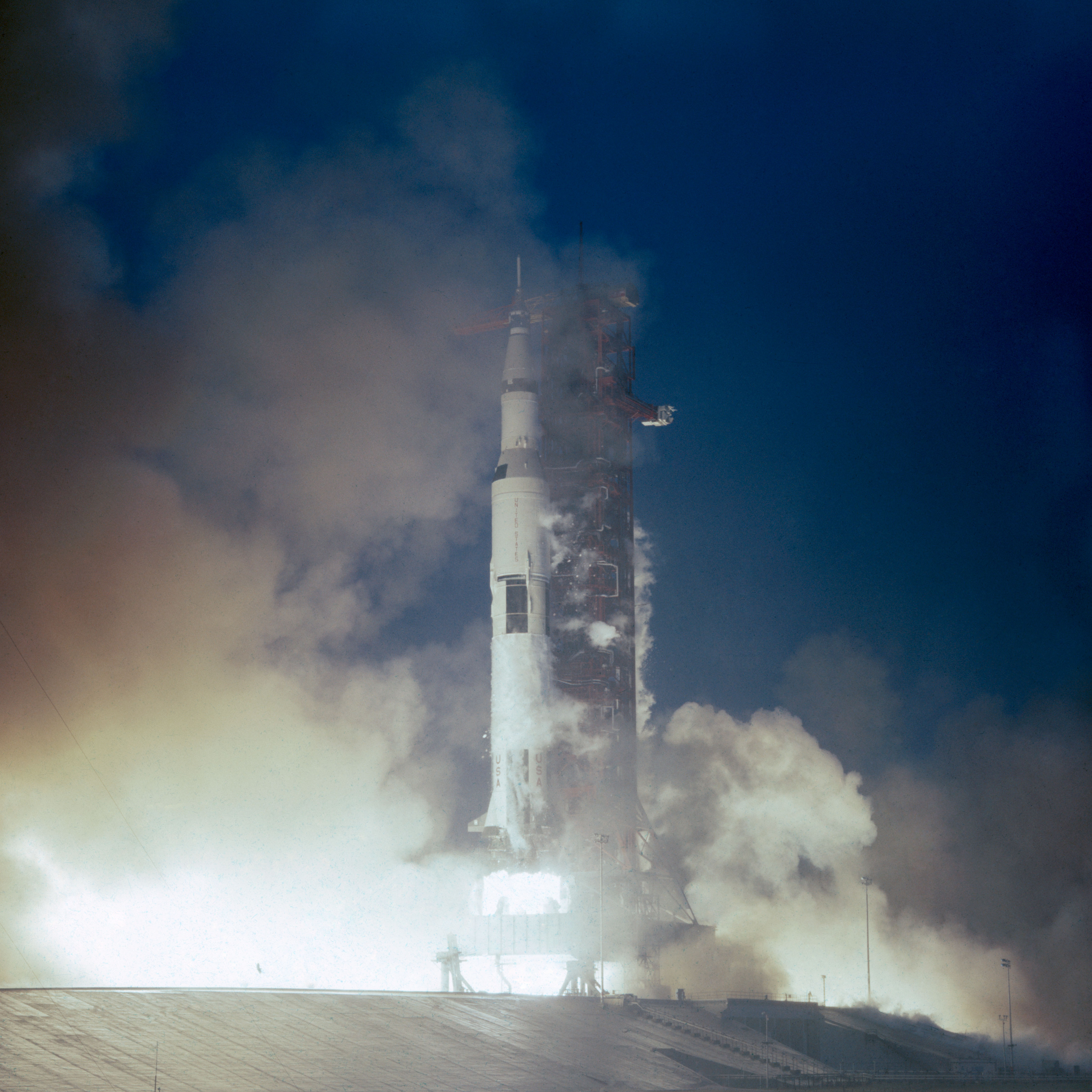
On Nov. 15, the second telecast occurred en route to the moon, showing the interior of the Yankee Clipper. Only one midcourse maneuver was needed. It changed Apollo 12’s trajectory to prepare for later insertion into a non-free-return lunar orbit – the first “hybrid” trajectory in Apollo flights. The spacecraft slowed so that it would arrive with the most desirable solar illumination on the selected Site 7.
Prior to lunar orbit insertion, a third telecast was made to Earth on Nov. 17, showing the Earth, moon, spacecraft interior and intravehicular transfer of the crew. Later that day, when Apollo 12 went behind the moon at about 97 miles up, the first lunar orbit insertion burn began. The burn lasted for about six minutes, placing the spacecraft into an elliptical orbit of 69 by 195 miles.
On Nov. 18, two orbits later and again on the far side of the moon, a second lunar orbit insertion burn altered Apollo 12 to an orbit of 62 by 76 miles. It was calculated to eventually circularize for the orbit of the solo CSM due to lunar-gravity potential. This would facilitate subsequent rendezvous and docking of Intrepid and the Yankee Clipper in their moon-parking orbit after the scheduled lunar landing. The same day, Conrad and Bean entered the LM and a telecast to Earth was made of the separation of the CSM and LM occurring 107 hours, 54 minutes into the flight.
On Nov. 19, with the LM behind the moon in the 14th orbit, and some 109 hours, 23 minutes into the mission, the descent orbit insertion maneuver began. The LM decent engine, or LMDE, fired for 29 seconds, lowering Intrepid’s orbit to about 9 by 69 miles. After the LM emerged from behind the moon and telemetry contact was re-established with Earth, a discrepancy was noted between orbit data readings from Intrepid and those displayed in Apollo Mission Control in Houston. The LM was initially believed to be in an incorrect descent orbit trajectory for landing in the desired region, due to normal mission anomalies. Using a newly developed “Lear” powered-flight data processor in Houston, the actual trajectory data, as well as correction maneuver information, were fed by voice to the LM crew. This enabled them to update the automatic downrange navigation computer program, shortening the range by 4,190 feet and permitting the precision touchdown at the intended site. This update to a satisfactory trajectory occurred about two minutes after the LM began its powered descent, which had been initiated at about 110 hours, 20 minutes into the mission and lasted a mere nominal 40 seconds longer than the preflight plan had scheduled. With Conrad controlling the descent semi-manually for the last 500 feet, a precision landing occurred at about 110 hours, 32 minutes into the mission, and closer to the target than expected. Intrepid landed in the Ocean of Storms at 3 degrees, 11 hours, 51 minutes south, and 23 degrees, 23 minutes, and 7.5 seconds west. Landing was about 120 feet northeast of Head Crater, and about 535 feet northwest from where Surveyor III stood in its crater. Apollo 12 touched down approximately 950 miles west of where Apollo 11 had landed.
Three hours after the landing and before the first extravehicular activity or, EVA, began. Richard Gordon, orbiting 69 miles up in the Yankee Clipper, was able to see both the Intrepid and Surveyor through the use of a 28-power sextant telescope. Conrad opened Intrepid’s hatch at 115 hours, 10 minutes into the mission to begin the first lunar EVA for the Apollo 12 crew. In their first lunar exploration, Conrad spent three hours, 39 minutes outside Intrepid, and Bean logged two hours, 58 minutes on the lurain. During this EVA, Conrad collected lunar surface samples and deployed both the S-band communication antenna and the solar wind experiment. Bean was assigned to mount the TV camera on a tripod. In the process of doing so, it was inadvertently pointed into the sun and ceased to function. The ALSEP instrumentation and SNAP-27 RTG were deployed within an arc of 600 to 700 feet of the LM. The ALSEP functioned satisfactorily, except for two items in the package, and was expected to yield data for up to two years. Deployment of the ALSEP took about an hour to complete. Throughout this first EVA, Conrad and Bean also took photographs of the experiment equipment, the spacecraft, the lurain and of themselves. Before entering the Intrepid, Bean took a 16-inch-deep core sample of the lunar surface and was followed back into the LM by Conrad. The first EVA ended at 119 hours, five minutes into the mission. The crew then ate, recharged their backpacks, prepared for the second EVA the following day, and slept for about five hours.
On Nov. 20, an hour and a half earlier than planned, the crew began the second EVA. Conrad left the Intrepid some 131 hours, 28 minutes into the mission. The second EVA included the collection of 70 pounds of rock and dirt samples, the retrieval of 10 to 15 pounds of randomly selected selenological samples, and further probing of two areas to retrieve lunar material from depths up to 32 inches below the surface. The crew retrieved the TV camera and stored it in the LM for return to Earth. The most important part of this second EVA was a 5,200-foot traverse of the lurain, ranging up to 1,300 feet from Intrepid. Walking northwest to the site of the ALSEP deployment, Conrad and Bean then turned south to perform a selenological rock survey. They skirted the rim of Head Crater, walked further south past Bench Crater, west around Sharp Crater, and back east past Bench Crater again, south of Halo Crater. Eventually they turned northeast, entering the 650-foot-wide Surveyor Crater to retrieve parts of Surveyor III, which was perched some 150 feet from the edge at the southern quadrant.
During the exploration, the astronauts discussed their findings by voice communication with geologists in Houston, who provided advice about which samples to retrieve. Surveyor was extensively photographed before parts were retrieved. The 17-pound TV camera was severed from its mount so that extensive studies could be performed on Earth of its gears, motors, optics, metals and lubricants. This would help determine the long-term effects of exposure to the elements. Similarly, the Surveyor’s motorized scoop, and pieces of TV cable, aluminum tubing and glass were gathered. Scientists on Earth were particularly interested in the cable because biological organisms had been trapped within it, and they wanted to know if any had survived.
Conrad and Bean then walked north, up a slope of about 14 degrees into Block Crater located on the rim of Surveyor Crater. They then turned west back to Intrepid, gathering surface samples as they went. They returned to the spacecraft at 134 hours, 49 minutes into the mission. Bean re-entered the LM at about 135 hours, 10 minutes, and Conrad followed at 135 hours, 22 minutes. The second EVA lasted three hours, 48 minutes. The crew removed their pressurized suits and jettisoned them on the moon before eating a meal.
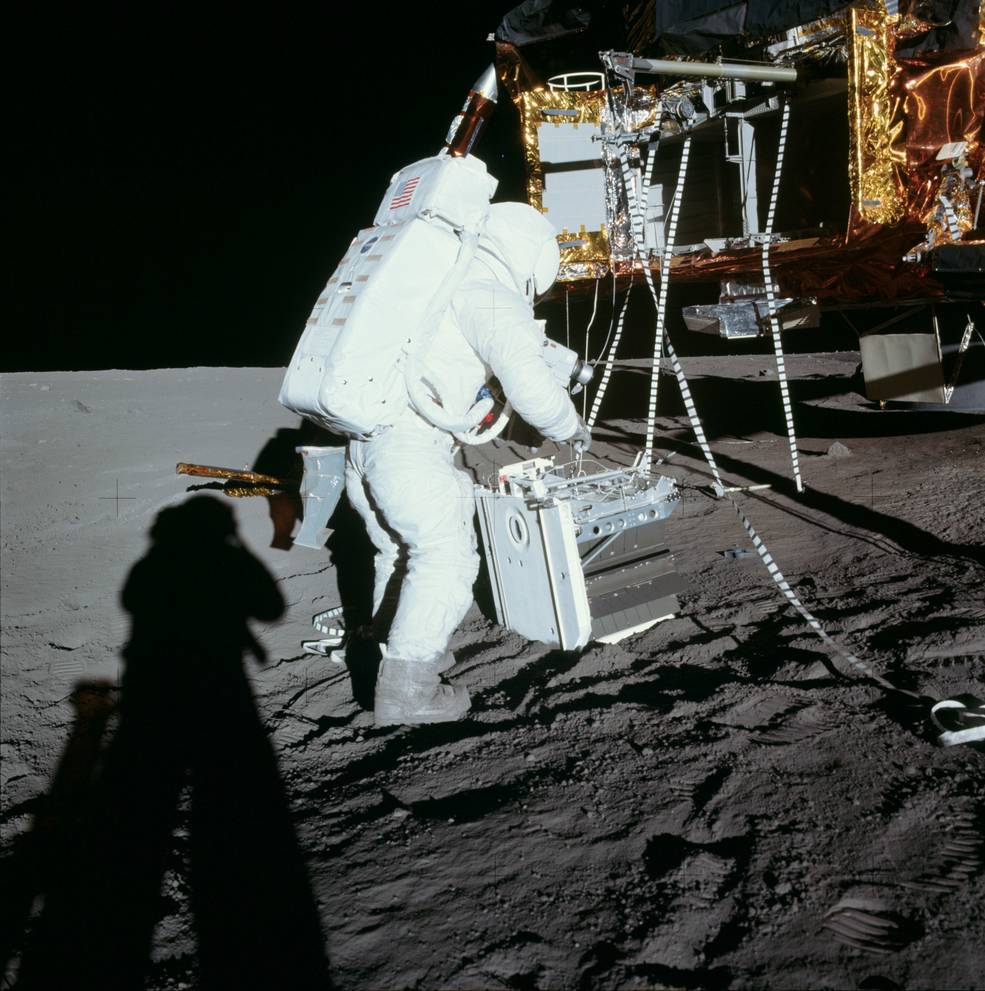
Approximately six hours later on the same day, after a total of 31.6 hours on the moon, the LM ascent stage fired for about seven minutes, putting Intrepid into an initial orbit of 10 by 54 miles for rendezvous and docking with the Yankee Clipper. About three and a half hours later, the rendezvous and docking maneuvers were televised to Earth by Gordon.
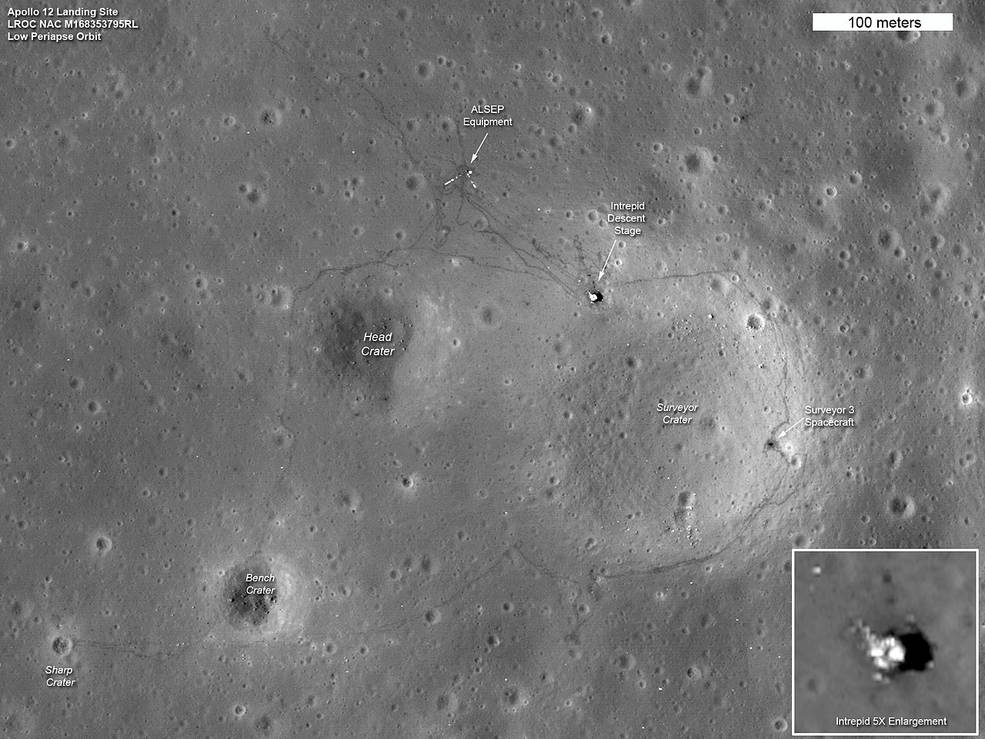
Following transfer to the CSM, the ascent stage jettisoned and deorbited to impact the moon. This provided predictable impact data for the ALSEP seismometer. Although planned to impact about six miles from the ALSEP, it landed about 40 miles away. The combined length and severity of the seismic disturbance set up by the impact, estimated to equal that of one ton of TNT. To the surprise of seismologists, strong signals lasted for more than a half hour, and weaker signals ceased about an hour later. The effects were studied, as was the data received from other experiments left on the moon.
A heavy schedule of photographing future landing sites on the lunar surface occurred from the CSM, preceded by a change of plane maneuver 3.8 degrees to the north, on the 39th lunar revolution. The maneuver was performed by a 19-second burn of the service propulsion system, or SPS. Earlier, while the Yankee Clipper was in its 27th and 28th revolutions, Gordon conducted the multi-spectral photographic survey of the lunar surface. During the 45th revolution and the 89th hour of the mission, the SPS ignited to put Apollo 12 into a trans-Earth trajectory. The trajectory occurred 172 hours, 27 minutes into the mission Nov. 21.
The return flight was uneventful. A midcourse correction maneuver occurred Nov. 22, when Apollo 12 was about 208,000 miles from Earth. On Nov. 23, when the spacecraft was 108,000 miles from Earth, the crew held a televised news conference, followed by sleep. A second scheduled midcourse correction maneuver was not needed. On Nov. 24, following the same nominal re-entry procedure scheduled for Apollo 11, Apollo 12 ended its 10-day flight by splashing down in the Pacific Ocean at 15 degrees, 46.6 minutes south latitude, and 165 degrees, 9 minutes west. Splashdown occurred about three miles from the target area, and three miles south of and within sight of the recovery ship USS Hornet. The splashdown occurred about 400 miles southeast of American Samoa, after a flight of 244 hours, 36 minutes, 25 seconds – just 62 seconds longer than planned.
Crew
Charles Conrad Jr., Commander
Alan L. Bean, Lunar Module Pilot
Richard F. Gordon Jr., Command Module Pilot
Backup Crew
David R. Scott, Commander
James B. Irwin, Lunar Module Pilot
Alfred M. Worden, Command Module Pilot
Payload
Yankee Clipper (CM-108)
Intrepid (LM-6)
Prelaunch Milestones
3/9/69- S-IVB ondock at Kennedy
4/21/69 – S-II stage ondock at Kennedy
5/3/69 – S-IC stage ondock at Kennedy
5/8/69 – S-IU ondock at Kennedy
Launch
Nov. 14, 1969; 11:22 a.m. EDT
Launch Pad 39A
Saturn-V AS-507
High Bay 3
Mobile Launcher-2
Firing Room 2
Orbit
Altitude: 118.55 miles
Inclination: 32.54 degrees
Orbits: 45 revolutions
Duration: 10 days, four hours, 36 minutes, 25 seconds
Distance: 952,354 miles
Lunar Location: Ocean of Storms
Lunar Coordinates: 3.04 degrees south, 23.42 degrees west
Landing
November 24, 1969; 3:58:24 p.m. EST
Pacific Ocean
Recovery Ship: USS Hornet
I gave a lecture about “Apollo 12 50th Anniversary and NASA’s Artemis Human return to the Moon” – on Nov 23 at the American Space Museum in Titusville, Florida.
www.spacewalkoffame.org/event/cosmic-christmas-yard-sale-and-apollo12-50th
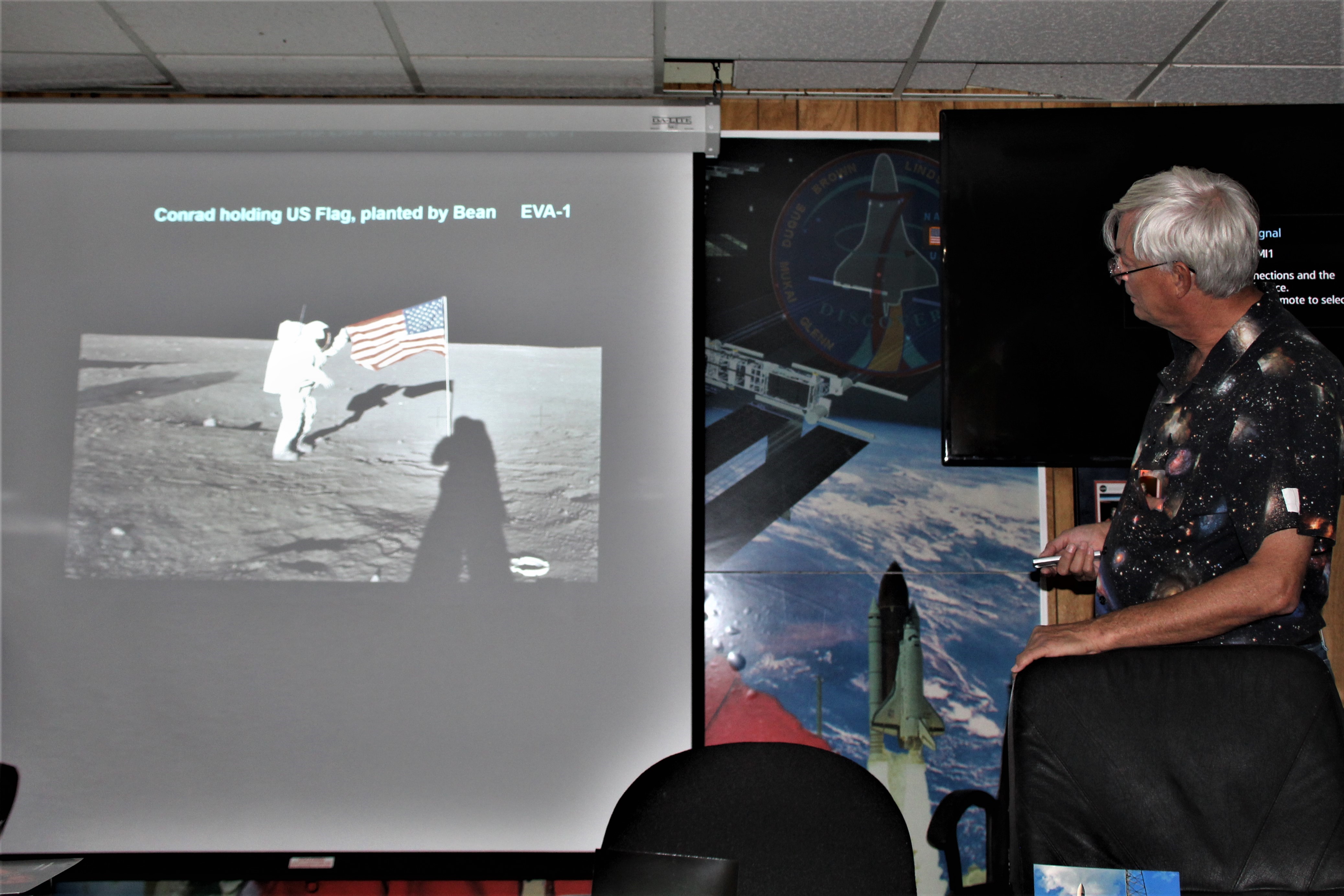
Stay tuned here for Ken’s continuing Earth and Planetary science and human spaceflight news: www.kenkremer.com –www.spaceupclose.com – twitter @ken_kremer – email: ken at kenkremer.com
Dr. Kremer is a research scientist and journalist based in the KSC area, active in outreach and interviewed regularly on TV and radio about space topics.
………….
Ken’s photos are for sale and he is available for lectures and outreach events
Ken’s upcoming outreach events:
Nov 23, 1 PM, Titusville, FL: “50th Anniversary Apollo 12 and NASA’s Human Return to the Moon with Project Artemis” at American Space Museum, Titusville, FL. Lecture free. Open to the public. Photos for sale
Website: www.spacewalkoffame.org
www.spacewalkoffame.org/event/cosmic-christmas-yard-sale-and-apollo12-50th
Dec 3/4: 7 PM, Quality Inn Kennedy Space Center, Titusville, FL. “SpaceX CRS-19 Launch to ISS Dec 4.” Free. In hotel lobby. Photos for sale
